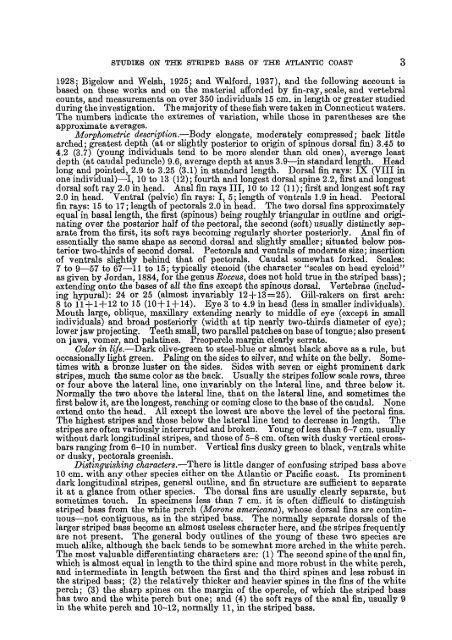Fishery bulletin of the Fish and Wildlife Service - NOAA
Fishery bulletin of the Fish and Wildlife Service - NOAA
Fishery bulletin of the Fish and Wildlife Service - NOAA
You also want an ePaper? Increase the reach of your titles
YUMPU automatically turns print PDFs into web optimized ePapers that Google loves.
STUDIES ON THE STRIPED BASS OF THE ATLANTIC COAST 3<br />
1928; Bigelow <strong>and</strong> Welsh, 1925; <strong>and</strong> Walford, 1937), <strong>and</strong> <strong>the</strong> following account is<br />
based on <strong>the</strong>se works <strong>and</strong> on <strong>the</strong> material afforded by fin-ray, scale, <strong>and</strong> vertebral<br />
counts, <strong>and</strong> measurements on over 350 individuals 15 cm. in length or greater studied<br />
during <strong>the</strong> investigation. The majority <strong>of</strong> <strong>the</strong>se fish were taken in Connecticut waters.<br />
The numbers indicate <strong>the</strong> extremes <strong>of</strong> variation, while those in paren<strong>the</strong>ses are <strong>the</strong><br />
approximate averages.<br />
Morphometric description.—Body elongate, moderately compressed; back little<br />
arched; greatest depth (at or slightly posterior to origin <strong>of</strong> spinous dorsal fin) 3.45 to<br />
4.2 (3.7) (young individuals tend to be more slender than old ones), average least<br />
depth (at caudal peduncle) 9.6, average depth at anus 3.9—in st<strong>and</strong>ard length. Head<br />
long <strong>and</strong> pointed, 2.9 to 3.25 (3.1) in st<strong>and</strong>ard length. Dorsal fin rays: IX (VIII in<br />
one individual)—-I, 10 to 13 (12) ; fourth <strong>and</strong> longest dorsal spine 2.2, first <strong>and</strong> longest<br />
dorsal s<strong>of</strong>t ray 2.0 in head. Anal fin rays III, 10 to 12 (11); first <strong>and</strong> longest s<strong>of</strong>t ray<br />
2.0 in head. Ventral (pelvic) fin rays: I, 5; length <strong>of</strong> ventrals 1.9 in head. Pectoral<br />
fin rays: 15 to 17; length <strong>of</strong> pectorals 2.0 in head. The two dorsal fins approximately<br />
equal in basal length, <strong>the</strong> first (spinous) being roughly triangular in outline <strong>and</strong> originating<br />
over <strong>the</strong> posterior half <strong>of</strong> <strong>the</strong> pectoral, <strong>the</strong> second (s<strong>of</strong>t) usually distinctly separate<br />
from <strong>the</strong> first, its s<strong>of</strong>t rays becoming regularly shorter posteriorly. Anal fin <strong>of</strong><br />
essentially <strong>the</strong> same shape as second dorsal <strong>and</strong> slightly smaller; situated below posterior<br />
two-thirds <strong>of</strong> second dorsal. Pectorals <strong>and</strong> ventrals <strong>of</strong> moderate size; insertion<br />
<strong>of</strong> ventrals slightly behind that <strong>of</strong> pectorals. Caudal somewhat forked. Scales:<br />
7 to 9—57 to 67—11 to 15; typically ctenoid (<strong>the</strong> character "scales on head cycloid"<br />
as given by Jordan, 1884, for <strong>the</strong> genus Boccus, does not hold true in <strong>the</strong> striped bass) ;<br />
extending onto <strong>the</strong> bases <strong>of</strong> all <strong>the</strong> fins except <strong>the</strong> spinous dorsal. Vertebrae (including<br />
hypural): 24 or 25 (almost invariably 12+13=25). Gill-rakers on first arch:<br />
8 to 11 + 1 + 12 to 15 (10+1 + 14). Eye 3 to 4.9 in head (less in smaller individuals).<br />
Mouth large, oblique, maxillary extending nearly to middle <strong>of</strong> eye (except in small<br />
individuals) <strong>and</strong> broad posteriorly (width at tip nearly two-thirds diameter <strong>of</strong> eye) ;<br />
lower jaw projecting. Teeth small, two parallel patches on base <strong>of</strong> tongue; also present<br />
on jaws, vomer, <strong>and</strong> palatines. Preopercle margin clearly serrate.<br />
Color in life.—Dark olive-green to steel-blue or almost black above as a rule, but<br />
occasionally light green. Paling on <strong>the</strong> sides to suVer, <strong>and</strong> white on <strong>the</strong> belly. Sometunes<br />
with a bronze luster on <strong>the</strong> sides. Sides with seven or eight prominent dark<br />
stripes, much <strong>the</strong> same color as <strong>the</strong> back. Usually <strong>the</strong> stripes follow scale rows, three<br />
or four above <strong>the</strong> lateral line, one invariably on <strong>the</strong> lateral line, <strong>and</strong> three below it.<br />
Normally <strong>the</strong> two above <strong>the</strong> lateral line, that on <strong>the</strong> lateral Une, <strong>and</strong> sometimes <strong>the</strong><br />
first below it, are <strong>the</strong> longest, reaching or coming close to <strong>the</strong> base <strong>of</strong> <strong>the</strong> caudal. None<br />
extend onto <strong>the</strong> head. All except <strong>the</strong> lowest are above <strong>the</strong> level <strong>of</strong> <strong>the</strong> pectoral fins.<br />
The highest stripes <strong>and</strong> those below <strong>the</strong> lateral line tend to decrease in length. The<br />
stripes are <strong>of</strong>ten variously interrupted <strong>and</strong> broken. Young <strong>of</strong> less than 6-7 cm. usually<br />
without dark longitudinal stripes, <strong>and</strong> those <strong>of</strong> 5-8 cm. <strong>of</strong>ten with dusky vertical crossbars<br />
ranging from 6-10 in number. Vertical fins dusky green to black, ventrals white<br />
or dusky, pectorals greenish.<br />
Distinguishing characters.—There is little danger <strong>of</strong> confusing striped bass above<br />
10 cm. with any o<strong>the</strong>r species ei<strong>the</strong>r on <strong>the</strong> Atlantic or Pacific coast. Its prominent<br />
dark longitudinal stripes, general outline, <strong>and</strong> fin structure are sufficient to separate<br />
it at a glance from o<strong>the</strong>r species. The dorsal fins are usually clearly separate, but<br />
sometimes touch. In specimens less than 7 cm. it is <strong>of</strong>ten difficult to distinguish<br />
striped bass from <strong>the</strong> white perch (Morone americana}, whose dorsal fins are continuous—not<br />
contiguous, as in <strong>the</strong> striped bass. The normally separate dorsals <strong>of</strong> <strong>the</strong><br />
larger striped bass become an almost useless character here, <strong>and</strong> <strong>the</strong> stripes frequently<br />
are not present. The general body outlines <strong>of</strong> <strong>the</strong> young <strong>of</strong> <strong>the</strong>se two species are<br />
much alike, although <strong>the</strong> back tends to be somewhat more arched in <strong>the</strong> white perch.<br />
The most valuable differentiating characters are: (1) The second spine <strong>of</strong> <strong>the</strong> anal fin,<br />
which is almost equal in length to <strong>the</strong> third spine <strong>and</strong> more robust in <strong>the</strong> white perch,<br />
<strong>and</strong> intermediate in length between <strong>the</strong> first <strong>and</strong> <strong>the</strong> third spines <strong>and</strong> less robust La<br />
<strong>the</strong> striped bass; (2) <strong>the</strong> relatively thicker <strong>and</strong> heavier spines in <strong>the</strong> fins <strong>of</strong> <strong>the</strong> white<br />
perch; (3) <strong>the</strong> sharp spines on <strong>the</strong> margin <strong>of</strong> <strong>the</strong> opercle, <strong>of</strong> which <strong>the</strong> striped bass<br />
has two <strong>and</strong> <strong>the</strong> white perch but one; <strong>and</strong> (4) <strong>the</strong> s<strong>of</strong>t rays <strong>of</strong> <strong>the</strong> anal fin, usually 9<br />
in <strong>the</strong> white perch <strong>and</strong> 10-12, normally 11, in <strong>the</strong> striped bass.

















